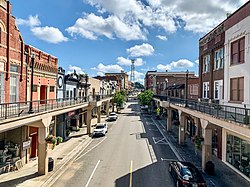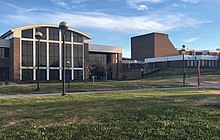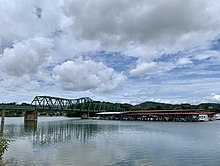New Market, Tennessee
New Market is a town in Jefferson County, Tennessee, United States. It is part of the Morristown metropolitan area. The population was 1,234 at the 2000 census and 1,334 at the 2010 census.[7]
New Market, Tennessee | |
|---|---|
| Town of New Market | |
 Old Andrew Johnson Highway in New Market | |
 Location of New Market in Jefferson County, Tennessee | |
| Coordinates: 36°6′6″N 83°32′59″W | |
| Country | United States |
| State | Tennessee |
| County | Jefferson |
| Settled | 1788[1] |
| Incorporated | 1911[2] |
| Area | |
| • Total | 4.23 sq mi (10.96 km2) |
| • Land | 4.23 sq mi (10.96 km2) |
| • Water | 0.00 sq mi (0.00 km2) |
| Elevation | 1,073 ft (327 m) |
| Population (2010) | |
| • Total | 1,334 |
| • Estimate (2019)[4] | 1,375 |
| • Density | 324.83/sq mi (125.42/km2) |
| Time zone | UTC-5 (Eastern (EST)) |
| • Summer (DST) | UTC-4 (EDT) |
| ZIP code | 37820 |
| Area code(s) | 865 |
| FIPS code | 47-52940[5] |
| GNIS feature ID | 1295602[6] |
History
On September 24, 1904, two passenger trains collided head-on near New Market, killing a large unknown number of passengers. Different sources give different values for the number of deaths, ranging from 54 to 113.[8][9][10]
There are many historical buildings in New Market, including the New Market Presbyterian Church which was built in 1885. The church was listed on the National Register of Historic Places in 1998.
New Market is the current home of the Highlander Research and Education Center.[11]
Geography
New Market is located in west-central Jefferson County at 36°6′6″N 83°32′59″W (36.101625, -83.549698).[12] It is bordered to the east by Jefferson City.
U.S. Route 11E (Andrew Johnson Highway) passes through the town, leading northeast 3 miles (5 km) to Jefferson City and 19 miles (31 km) to Morristown, and southwest 24 miles (39 km) to Knoxville.
According to the United States Census Bureau, New Market has a total area of 4.1 square miles (10.7 km2), all land.[7] The town sits in the valley of Lost Creek, a west-flowing tributary of the Holston River.
Demographics
| Historical population | |||
|---|---|---|---|
| Census | Pop. | %± | |
| 1880 | 354 | — | |
| 1980 | 1,216 | — | |
| 1990 | 1,086 | −10.7% | |
| 2000 | 1,234 | 13.6% | |
| 2010 | 1,334 | 8.1% | |
| Est. 2019 | 1,375 | [4] | 3.1% |
| Sources:[13][14] | |||
As of the census[5] of 2000, there were 1,234 people, 473 households, and 366 families residing in the town. The population density was 479.2 people per square mile (184.7/km2). There were 521 housing units at an average density of 202.3 per square mile (78.0/km2). The racial makeup of the town was 92.38% White, 3.89% African American, 0.08% Native American, 0.41% Asian, 2.11% from other races, and 1.13% from two or more races. Hispanic or Latino of any race were 3.65% of the population.
There were 473 households, out of which 30.2% had children under the age of 18 living with them, 61.7% were married couples living together, 11.2% had a female householder with no husband present, and 22.6% were non-families. 20.7% of all households were made up of individuals, and 10.4% had someone living alone who was 65 years of age or older. The average household size was 2.61 and the average family size was 2.98.
In the town, the population was spread out, with 23.9% under the age of 18, 8.1% from 18 to 24, 28.7% from 25 to 44, 25.3% from 45 to 64, and 14.0% who were 65 years of age or older. The median age was 38 years. For every 100 females, there were 105.0 males. For every 100 females age 18 and over, there were 95.2 males.
The median income for a household in the town was $39,583, and the median income for a family was $45,298. Males had a median income of $29,828 versus $19,900 for females. The per capita income for the town was $17,439. About 4.3% of families and 5.7% of the population were below the poverty line, including 3.0% of those under age 18 and 15.7% of those age 65 or over.
Notable people
- Frances Hodgson Burnett (November 24, 1849 – October 29, 1924) was an English–American playwright and author. She is best known for her children's stories, in particular The Secret Garden, A Little Princess, and Little Lord Fauntleroy. She lived in New Market during her younger years.
- John Casper Branner (July 4, 1850 – March 1, 1922), geologist and academic, was born in New Market and lived there until two years of age.
References
- Nancy Capace, Encyclopedia of Tennessee (North American Book Distributors, 2000), p. 209.
- Tennessee Blue Book, 2005-2006, pp. 618-625.
- "2019 U.S. Gazetteer Files". United States Census Bureau. Retrieved July 30, 2020.
- "Population and Housing Unit Estimates". United States Census Bureau. May 24, 2020. Retrieved May 27, 2020.
- "U.S. Census website". United States Census Bureau. Retrieved 2008-01-31.
- "US Board on Geographic Names". United States Geological Survey. 2007-10-25. Retrieved 2008-01-31.
- "Geographic Identifiers: 2010 Census Summary File 1 (G001): New Market town, Tennessee". American Factfinder. U.S. Census Bureau. Archived from the original on February 13, 2020. Retrieved November 28, 2018.
- "New Market Wreck," From Tipple, Loom, & Rail, Smithsonian Institution "History Wired" website
- History of the New Market Train Wreck Archived 2013-12-02 at the Wayback Machine, New Market Elementary School website
- Knoxville News Sentinel Archived 2007-04-17 at the Wayback Machine
- "Highlander Research and Education Center". highlandercenter.org. Retrieved 2017-11-08.
- "US Gazetteer files: 2010, 2000, and 1990". United States Census Bureau. 2011-02-12. Retrieved 2011-04-23.
- "Census of Population and Housing: Decennial Censuses". United States Census Bureau. Retrieved 2012-03-04.
- "Incorporated Places and Minor Civil Divisions Datasets: Subcounty Resident Population Estimates: April 1, 2010 to July 1, 2012". Population Estimates. U.S. Census Bureau. Archived from the original on 11 June 2013. Retrieved 11 December 2013.
External links
- Municipal Technical Advisory Service entry for New Market – information on local government, elections, and link to charter
| Wikimedia Commons has media related to New Market, Tennessee. |


